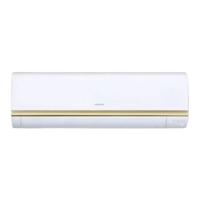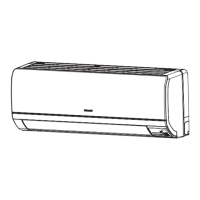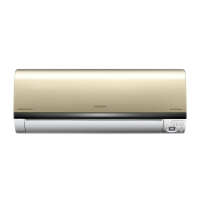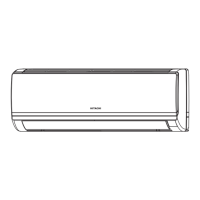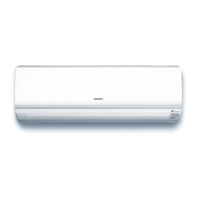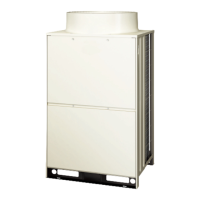Do you have a question about the Hitachi RAS-X18HAK and is the answer not in the manual?
Follow instructions for installation to prevent faults, water leakage, electric shock, or fire.
Contact authorized personnel for shifting, maintenance, or repairs to avoid electric shock and fire.
Covers safety measures for operating the air conditioner, including avoiding direct airflow and hazards.
Identifies and describes components of the indoor air conditioning unit, such as air filter and indicators.
Identifies and describes components of the outdoor air conditioning unit, such as drain pipe and air inlet.
Lists the model numbers and physical dimensions (width, height, depth) for the units.
Explains the meaning and function of indicator lights and the auto restart feature.
Provides recommended maximum and minimum operating temperatures for cooling and heating modes.
Details the remote control unit's functions, buttons, and usage precautions.
Explains how to select operation modes (Heating, Dehumidifying, Cooling) using the remote.
Details how to adjust room temperature settings for different modes and provides recommended values.
Explains how to set fan speed for Heating, Cooling, and Dehumidifying modes.
Describes how to stop the unit operation using the STOP button.
Instructions on setting the timer to turn the unit off at a specified time.
Instructions on setting the timer to turn the unit on at a specified time.
Instructions on setting the sleep timer for automatic unit shutdown.
Details how the sleep timer automatically controls fan speed and room temperature during heating and cooling.
Explains how to adjust the horizontal air deflector for upward/downward airflow using the AUTO SWING button.
Explains how to manually adjust the vertical air deflector for left/right airflow.
Advises on setting appropriate room temperatures for health and energy efficiency.
Recommends using curtains or blinds to reduce heat entry from windows.
Emphasizes the need for periodic ventilation by opening doors and windows for fresh air.
Suggests using timer functions for comfortable room temperature, especially at night.
Highlights the need to clean the pre-filter every 2 weeks to maintain air volume and cooling efficiency.
Advises caution regarding room temperature and airflow direction for babies, children, and the elderly.
Explains that high heat load in the room may prevent achieving the set temperature.
Recommends unplugging the unit when not in use for extended periods to save power.
Advises to stop operation and unplug the unit during lightning for protection.
Recommends placing the unit and remote at least 1m away from other electrical products to avoid interference.
Detailed instructions for removing, cleaning, and reinstalling the dust filter screen.
Guidance on cleaning the evaporator annually using a soft brush or vacuum cleaner.
Provides instructions for cleaning the front panel of the unit using soft cloths and mild detergent.
Check power supply plug is properly connected if the unit is not operating.
Troubleshooting steps for common issues like clogged filters, direct sunlight, airflow blockage, and incorrect settings.
Check points for regular half-yearly or yearly inspections including plug, earth line, and mounting frame stability.
Points to check before requesting service: unit status, cooling/heating performance, and operational notes.
Follow instructions for installation to prevent faults, water leakage, electric shock, or fire.
Contact authorized personnel for shifting, maintenance, or repairs to avoid electric shock and fire.
Covers safety measures for operating the air conditioner, including avoiding direct airflow and hazards.
Identifies and describes components of the indoor air conditioning unit, such as air filter and indicators.
Identifies and describes components of the outdoor air conditioning unit, such as drain pipe and air inlet.
Lists the model numbers and physical dimensions (width, height, depth) for the units.
Explains the meaning and function of indicator lights and the auto restart feature.
Provides recommended maximum and minimum operating temperatures for cooling and heating modes.
Details the remote control unit's functions, buttons, and usage precautions.
Explains how to select operation modes (Heating, Dehumidifying, Cooling) using the remote.
Details how to adjust room temperature settings for different modes and provides recommended values.
Explains how to set fan speed for Heating, Cooling, and Dehumidifying modes.
Describes how to stop the unit operation using the STOP button.
Instructions on setting the timer to turn the unit off at a specified time.
Instructions on setting the timer to turn the unit on at a specified time.
Instructions on setting the sleep timer for automatic unit shutdown.
Details how the sleep timer automatically controls fan speed and room temperature during heating and cooling.
Explains how to adjust the horizontal air deflector for upward/downward airflow using the AUTO SWING button.
Explains how to manually adjust the vertical air deflector for left/right airflow.
Advises on setting appropriate room temperatures for health and energy efficiency.
Recommends using curtains or blinds to reduce heat entry from windows.
Emphasizes the need for periodic ventilation by opening doors and windows for fresh air.
Suggests using timer functions for comfortable room temperature, especially at night.
Highlights the need to clean the pre-filter every 2 weeks to maintain air volume and cooling efficiency.
Advises caution regarding room temperature and airflow direction for babies, children, and the elderly.
Explains that high heat load in the room may prevent achieving the set temperature.
Recommends unplugging the unit when not in use for extended periods to save power.
Advises to stop operation and unplug the unit during lightning for protection.
Recommends placing the unit and remote at least 1m away from other electrical products to avoid interference.
Detailed instructions for removing, cleaning, and reinstalling the dust filter screen.
Guidance on cleaning the evaporator annually using a soft brush or vacuum cleaner.
Provides instructions for cleaning the front panel of the unit using soft cloths and mild detergent.
Check power supply plug is properly connected if the unit is not operating.
Troubleshooting steps for common issues like clogged filters, direct sunlight, airflow blockage, and incorrect settings.
Check points for regular half-yearly or yearly inspections including plug, earth line, and mounting frame stability.
Points to check before requesting service: unit status, cooling/heating performance, and operational notes.
| Refrigerant | R410A |
|---|---|
| Inverter Technology | Yes |
| Power Supply | 220-240 V, 50 Hz |
| Type | Split |
| Power Supply (V) | 220-240 |
| Refrigerant (Alt) | R410A |
| Outdoor Unit Dimensions (W x H x D) (Alt) | 780 x 540 x 285 mm |
